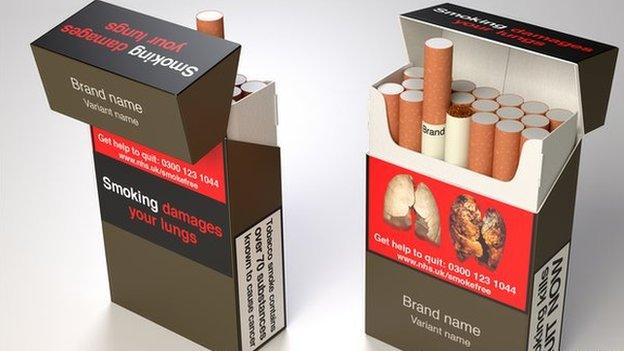Are anti-smoking measures working?
- Published

Along with Australia, the UK can probably claim to be the toughest nation in the world when it comes to trying to stub out smoking.
Take a look at what has happened over the past decade. There has been a ban on smoking in public places, the introduction of graphic warnings on packs and a ban on shops displaying tobacco products.
Now it appears standardised packaging is going to be introduced, following hot-on-the heels of the decision last month to ban smoking in cars when children are present.
Some areas are even looking at banning smoking in squares and parks.
Only the home remains sacrosanct it seems - and smoking lobby group Forest has even wryly suggested that will be next on the hit list.
'Modest' impact
But do these measures work? A quick glance at the smoking rate can give the impression they don't.
Let's look at what has happened over the past 20 years. This is the period when governments have been particularly active.
In the mid 1990s 27% of people smoked. By 2013 that had fallen to 19%. By comparison, the 20 years before that - the mid 1970s to mid 1990s - saw the rate fall from 45%.
What is more, even this latest step is only likely to have a "modest" impact, according to Sir Cyril Chantler, external, the paediatrician who reviewed the evidence on standardised packaging for the government last year.

A history of smoking legislation in the UK

1965: Government bans cigarette advertising on television
1971: Ministers announce health warnings to be carried on all cigarette packets
1984: Smoking banned on London underground trains
2002: Legislation passed banning tobacco advertising, promotion and sponsorship
2005: Smoking banned on all trains
2006: A ban on smoking in public places, including bars and restaurants, comes into effect in Scotland
2007: England, Wales and Northern Ireland introduce their own bans on smoking in public places
2008: Picture health warnings introduced on cigarette packets
2012: Large shops are banned from displaying cigarettes. Smaller shops to follow suit in 2015
2015: MPs vote in favour of banning smoking in cars where children are present

Does that mean that tough legislation doesn't work? Not necessarily. The proportion of smokers used to be so high that it was only natural as the evidence grew about the risks the numbers would fall relatively quickly.
What you are left with is the hard-core group of smokers. This is the point we have reached now - hence the desire among health experts to keep pushing for ever tougher measures.
Action on Smoking and Health's chief executive Deborah Arnott says: "I think we should consider what has happened for the last decade or two a real success. It gets harder as you go on, but the figures are still falling.
"It impossible to prove exactly what impact each piece of legislation has had and you have to see it all in context of the health awareness campaigns that have been run too. Whatever we are doing, it is working."

How the standardised packets may look
Focussing solely on the numbers of smokers also misses an important element of what campaigners and ministers are trying to achieve with the legislation.
Firstly, some of it has been aimed at reducing exposure to second-hand smoke - something that the smoking ban in public places certainly achieved, according to research published in 2011 by Stirling University, external.
Secondly, as well as reducing the numbers of people who smoke, the aim has been to stop people taking it up in the first place.
Since the 1970s, the proportion of the population which has never smoked increased from 37% to 58%.
And in recent years the progress in discouraging children from taking up smoking has been particularly impressive.
Between 1982 and 2006, the number of 15-year-olds who regular smoked hovered between 20% and 25%, according to the Health and Social Care Information Centre. Since then it has dropped to 8%.
This is what ministers and health campaigners call "denormalising" smoking - and in trying to achieve that goal, it could be said no stone is being left unturned.
Follow Nick on Twitter, external.